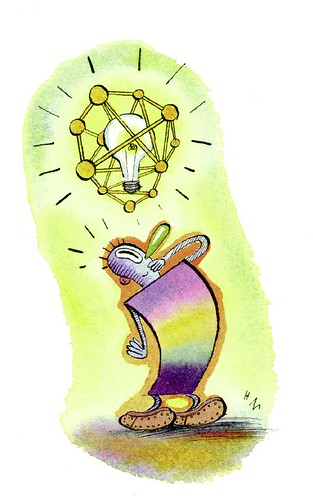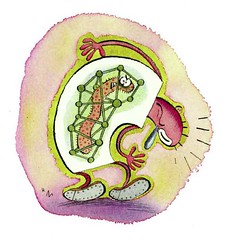
Illustrations by Hal Mayforth
In 1959 renowned Caltech physicist Richard Feynman pondered the possibilities of just how small technology could get in his seminal lecture, “There’s Plenty of Room at the Bottom.” He foresaw a world of extremely small machines manufactured at the atomic scale–from the bottom up–by direct manipulation of atoms.
While devices like semiconductors have shrunk exponentially in the nearly 50 years since Feynman challenged the next generation of scientists and engineers to dream small, thus far the reality has fallen far short of what Feynman described.
But now the burgeoning field of nanotechnology is offering a tantalizing universe of possibilities. Imagine concrete that is virtually indestructible, lighting that requires one-tenth the energy of conventional sources, cancer detection when only a few cells are present.
Nanotechnology promises all this and more. Vanderbilt is one of the nation’s leading institutions in nanotechnology research, having received 10 percent of all National Institutes of Health funding for nanotechnology in biology and medicine.
At the heart of the effort is the Vanderbilt Institute for Nanoscale Engineering (VINSE): a community of chemists, biologists, physicists, physicians and engineers that fosters interdisciplinary collaboration and creativity. Since its inception in 2001, VINSE has garnered more than $47 million in federal funding to explore the structure, novel properties and applications of nanomaterials.
What Is Nanotechnology, Anyway?
“Nano” (from the Greek nanos for “dwarf”) means one-billionth. Measurements at this scale are made in nanometers (nm), or one-billionth of a meter. To put this in perspective, a human hair is some 90,000 nm wide, and 1 nm is the width of just 10 hydrogen atoms. We’re talking small.
We’re also talking weird. Materials this small just don’t behave like they do in the macro world. At these scales the familiar laws of physics are left behind, and you enter the realm where quantum mechanics holds sway. Materials take on new and often strange properties. These novel properties have convinced researchers that small is the next big thing.
“That’s the great thing about nano and why it’s so fascinating,” says Sandra Rosenthal, associate professor of chemistry, physics and pharmacology and director of VINSE. “You get down to the nanometer-size regime, and you don’t know what you’re going to get. If you make a new nanomaterial, it’s going to have properties that you may not have predicted, and it’s those properties that lead to fantastic applications.”

Solid-State Lighting
Right now 30 percent of the electricity generated in the United States goes to lighting, the bulk of which is incandescent and only 5 percent efficient. One area of Rosenthal’s research involves the chemical synthesis of semiconducting nanocrystals–also called quantum dots–in sizes less than 6 nm. Because they are semiconductors, they behave like solid-state light-emitting diodes, or LEDs. Her lab has been making smaller and smaller nanocrystals and studying their light-emitting properties.
“As you make the nanocrystals smaller,” Rosenthal says, “they go through the colors of the spectrum: The big ones are red, and it goes just like a rainbow through orange, yellow, green, to blue. We made them so small that we thought they were going to be blue, but when we put them in front of a laser, the room lit up in this beautiful white light.” It turns out that at the magic size of 1.5 nm, the nanocrystals, which normally emit only a narrow wavelength of light, emit the entire spectrum, producing almost perfectly white light.
“My graduate student, Mike Bowers, demonstrated that by coating the surface of a cheap blue LED with a urethane mixture containing these nanocrystals, you can convert the blue light into white light,” says Rosenthal.
The impact of a solid-state white-light emitter could be huge. LEDs consume only one-tenth of the electricity for the same amount of light as an incandescent bulb, and they last much longer.
The Department of Energy would like to see the United States transition to solid-state lighting by the year 2025. The problem is that current white-light LEDs are expensive to make, and their light is actually bluish–not an attractive option for home or office lighting.
“So what’s great about the nanocrystals is that–for not a lot of money–we already exceed the Department of Energy’s 2025 standard for color quality because the white light they emit is so beautiful,” says Rosenthal. “The Department of Energy estimates that solid-state lighting could save U.S. consumers more than $10 billion per year in energy costs, as well as a big reduction in CO2 emissions produced by generating the electricity. So you win both ways.”
Early Virus Detection
A few doors down from Rosenthal’s office, David Wright is interested in the application of quantum dots to help solve a common medical dilemma.
“Everyone who has a child is familiar with late nights, high fevers, and not knowing why their child is sick,” says Wright, who is assistant professor of chemistry and associate professor of pediatrics. “Parents wonder if they should call the doctor at 2 a.m. or go to the emergency room.”
Unfortunately, many times after children are admitted to the hospital, their fever can break. They’re well on the way to getting better before any diagnosis can be made, and even then it can be inconclusive.
“The question we were interested in was how to figure out what your little one was sick with,” says Wright. “Nanotechnology offers not just one way, but several ways to do it.”
Respiratory syncytial virus (RSV) is the leading cause of lower respiratory tract infections in babies and children. Its symptoms make it difficult to distinguish from the common cold, yet RSV can lead to pneumonia, bronchiolitis and other serious illnesses.
Wright and his collaborators use quantum dots of different sizes and bind them to the two proteins that respiratory syncytial virus uses to attach and fuse to the host cell. One size quantum dot binds to the attachment protein and emits red light, the other to the fusion protein and emits green. When the sample is viewed under the clinical lab’s plate reader or optical fluorescent microscope, the colors are easily identifiable. Where the colors overlap appears yellow and indicates a colocalization of the proteins, confirming that the cell has been infected.
“This is as close to off-the-shelf nanotechnology as a scientist can get. We’re not talking about five or 10 years down the road. We’re talking today.”
~ Professor David Wright
“In typical clinical culture assays, it can take three days before you have a high enough concentration of protein to detect with an organic dye and allow a diagnosis,” Wright says. “With quantum dots we can get positive results within one hour of infection. We can use more dots and test for several viruses simultaneously with one tiny sample. Whether the test is positive or negative, the child spends a fraction of the time in the hospital bed waiting for results.”
Wright is adamant that this technology could be implemented very quickly. “This is about as close to off-the-shelf nanotechnology as a scientist can get,” Wright says. “These quantum dots are commercially available, the antibodies are available, and the clinics have the equipment.
“We’re not talking about something that can be done five years or 10 years down the road. We’re talking today.”
Early Cancer Detection
Over in biomedical engineering, Todd Giorgio is part of a team that has received international recognition for its work using nanomaterials to detect cancers at the earliest stage, when only a few cells are present.
“We use quantum dots that we engineer to bind to proteins that are exclusively associated with cancer,” says Giorgio, who is chair and professor of biomedical engineering and professor of chemical engineering. “We start with a suspension of quantum dots that are much too small to see individually. Then we add the cancer protein, and the particles bind to it, forming a clump or aggregate. We can see these aggregates with a flow cytometer, which is standard equipment in every clinical lab.”
Because quantum dots are available in many different colors, each color could be used as a marker for a different protein. “So you could take one sample of blood, add the quantum dots, use a flow cytometer to look for the different proteins associated with a cancer, and get a yes or no answer.”
Another strategy Giorgio is exploring involves the use of iron-oxide nanoparticles engineered to bind to cancer cells. “The survival rates of primary cancers are quite good if the patient comes in with only a primary tumor,” Giorgio says. “If the cancer has metastasized, the survival rate drops dramatically.”
These metastases are extremely hard to spot by MRI. But the iron-oxide nanoparticles bind to the metastases, increasing their contrast and making them much more visible.
“Physicians could better identify patients with metastases and change their treatment from Day One,” Giorgio says.

Stronger, Lighter Concrete
The tragedy of the Minneapolis bridge collapse on Aug. 1, 2007, brought the nation’s aging infrastructure into sharp focus. According to the National Highway Administration, 81,000 bridges in the United States are deemed structurally deficient, and another 81,000 are functionally obsolete. Nanofiber research could have a major impact on the next generation of repair and replacement of these aging structures.
“Cement is one of the oldest and most common building materials in the world. It’s everywhere,” says Florence Sanchez. “The problem is that the cement we use nowadays degrades. We’re trying to understand and modify this material at the nanoscale level to see if we can make a new material that is stronger and lasts longer.”
Sanchez, an assistant professor of civil and environmental engineering, is investigating the use of nanofibers in concrete to improve its strength and durability. “I’m very interested in the way the material degrades or weathers over time,” she says. “If we can make the concrete strong enough, then we might be able to do away with steel reinforcing rods–rebar–which are major sources of degradation.”
Modification of concrete also could expand its abilities. “Concrete itself doesn’t conduct electricity,” says Sanchez. “But if you add carbon nano- or microfibers that do conduct electricity, then you have a material that is going to conduct electricity, which opens up new applications–like roads that warm themselves up in the winter.”
What’s Next?
Other applications of nanotechnology being researched and developed at VINSE range from ultra-thin coatings for hypersonic (think super-supersonic) vehicles to the generation of electricity from the proteins in spinach cells. While it is unclear just how nanotechnology will impact your life and standard of living in the very near future, it is a certainty that it will. New materials lead to new properties and new applications, which in turn lead to more questions. And so it goes.
There’s still plenty of room at the bottom.